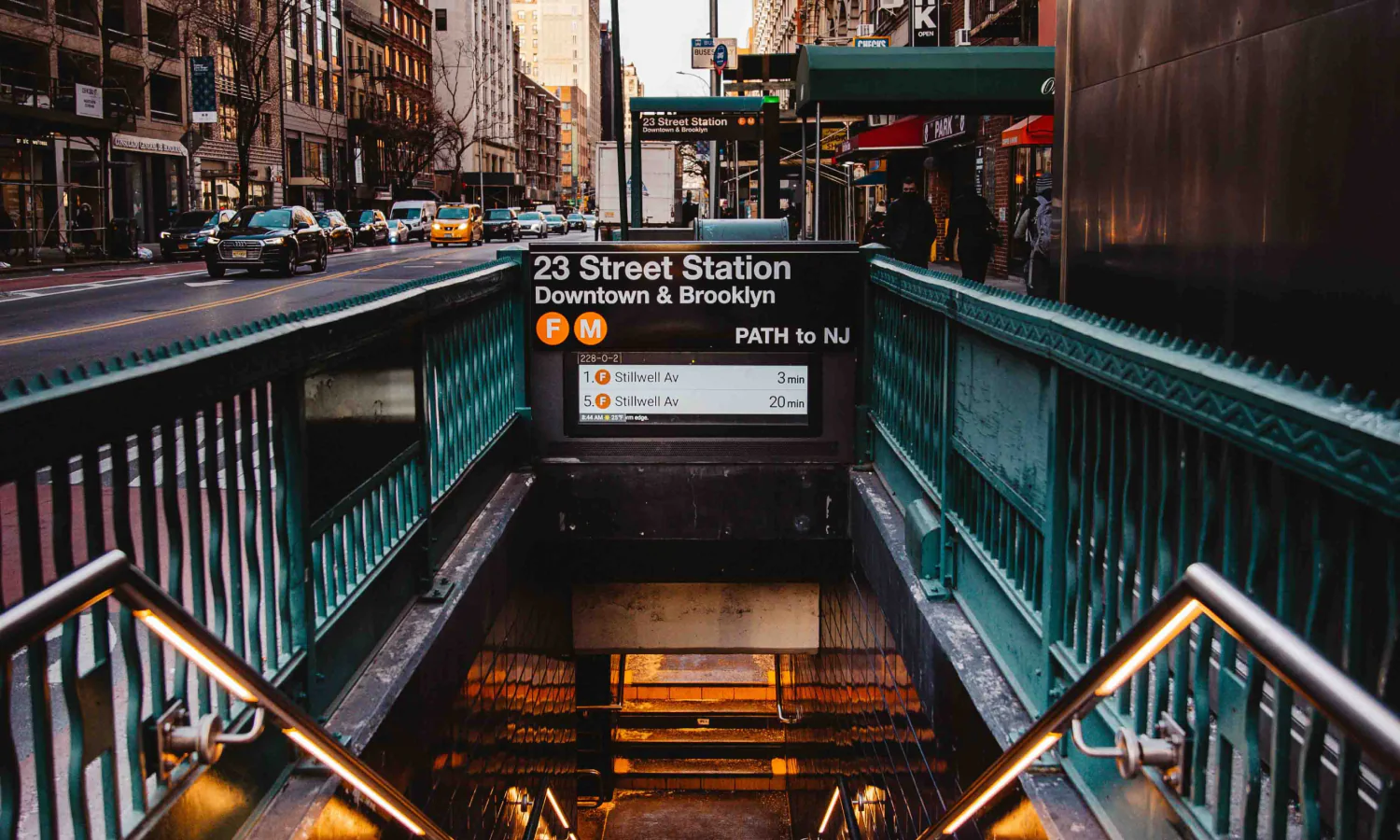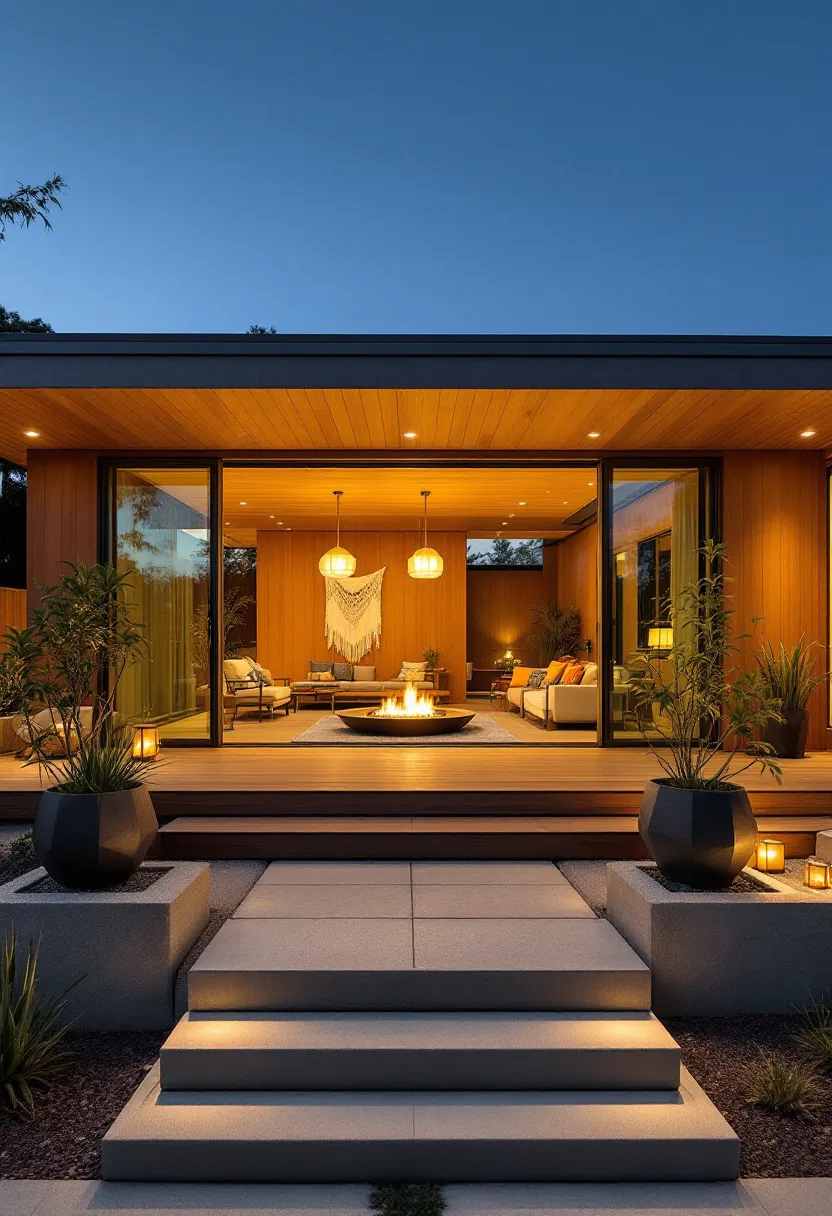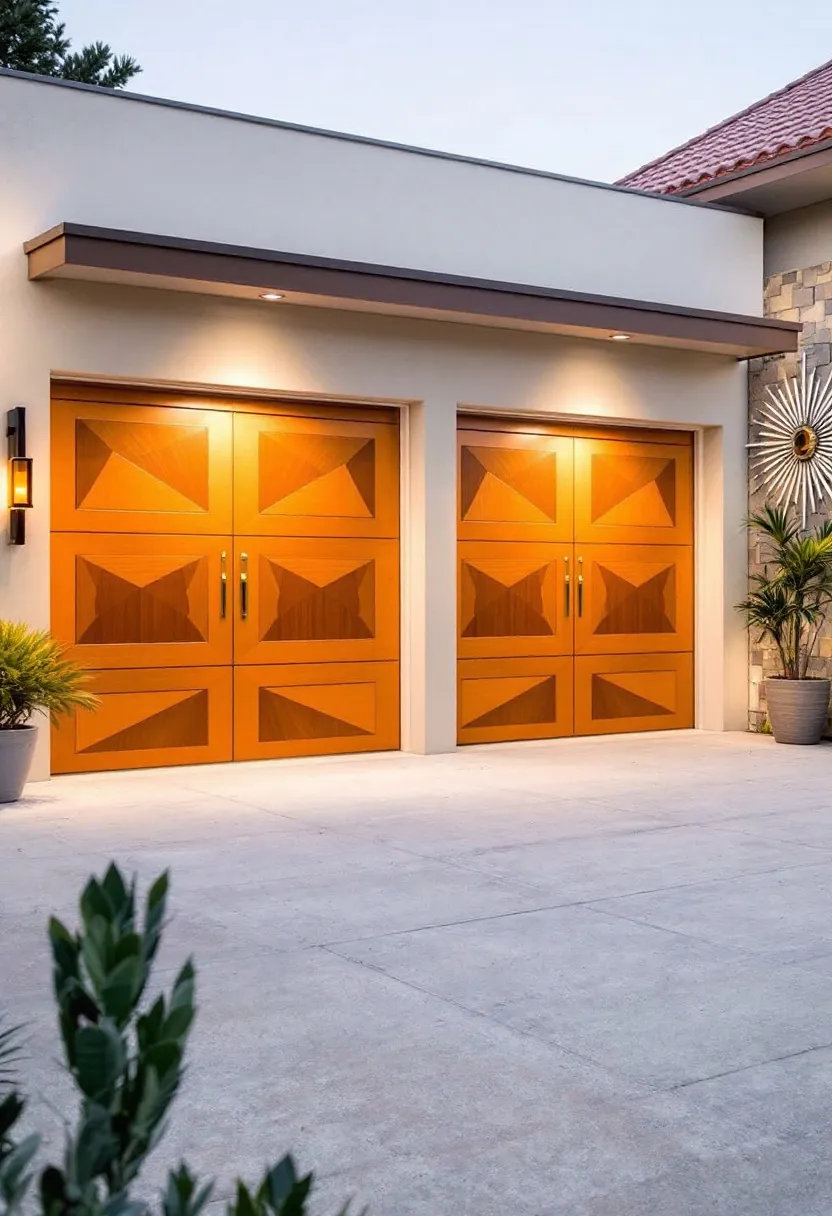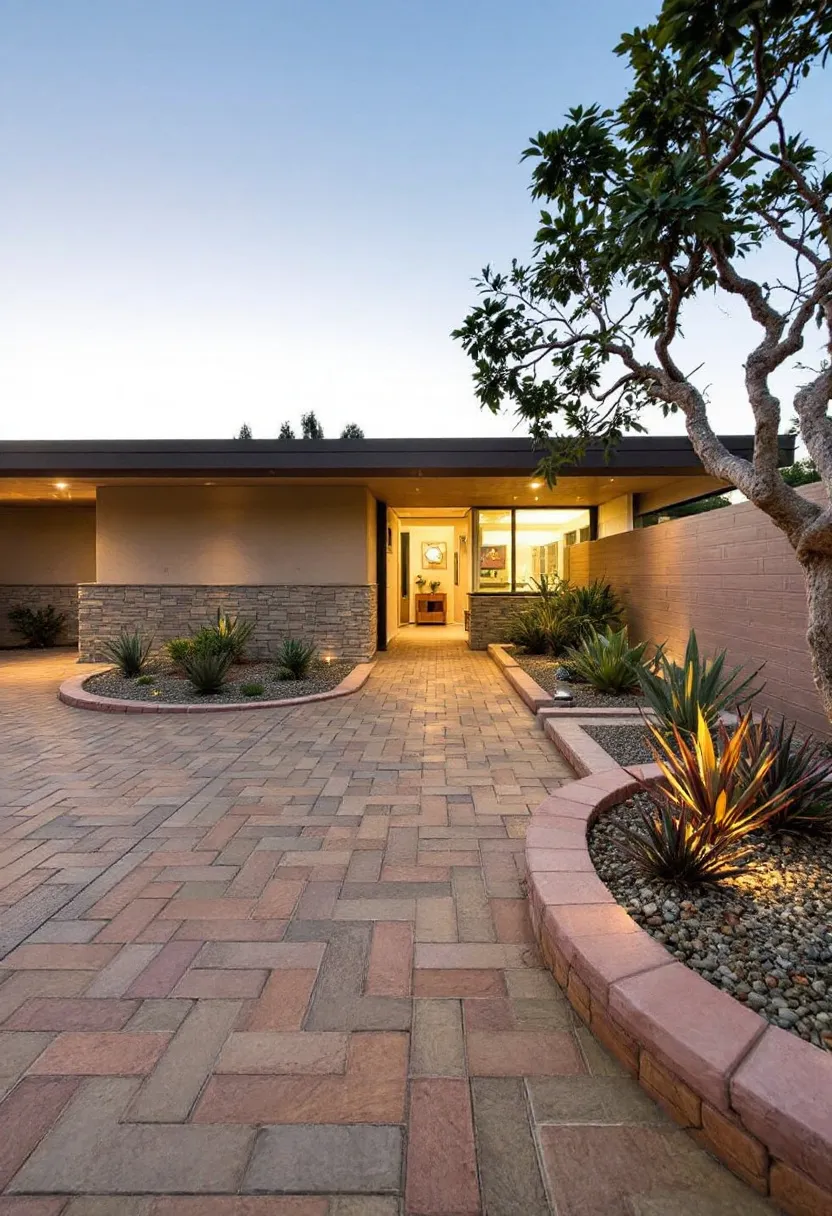
Newsletter Subscribe
Enter your email address below and subscribe to our newsletter

I’ve always been drawn to the striking character of 1970s exterior design—an era that architects continue to reference for good reason. From dramatic rooflines to textural combinations that create visual interest without excessive ornamentation, these often-overlooked elements offer practical solutions for modern homes seeking distinctiveness. Discover how these seven authentic 70s features can transform your home’s exterior while providing the added benefits of improved natural lighting and energy efficiency that today’s homeowners value.

Modern 70s Exterior design features striking geometric patterns paired with warm natural materials like teak and terrazzo, creating a bold yet inviting entry that balances vintage appeal with contemporary sensibilities. A thoughtfully designed front entrance transforms everyday arrivals and departures into moments of delight while addressing practical concerns such as weather protection, security, and transitional spaces between outdoors and in.


Revitalizing your home’s façade with The Secret Color Formula for a Stunning 70s Color Palette allows you to make a memorable statement that stands apart from cookie-cutter neighborhood designs while maintaining a connection to architectural history. Earthy oranges, rich browns, and vibrant accent colors work harmoniously against textural elements like macramé wall hangings and architectural planters, ensuring your home’s exterior reflects both personal style and the distinctive aesthetic appeal that made 70s design so revolutionary.


Modern 70s exterior entryways showcase dramatic wooden paneling paired with expansive sliding glass doors that create a seamless connection between indoor conversation pits and outdoor deck spaces. Such architectural elements address common household challenges by maximizing natural light while maintaining privacy through strategically placed geometric planters and drought-resistant landscaping that requires minimal maintenance.


Incorporating nostalgic 70s home office designs into contemporary spaces brings unexpected functionality through adaptable features like recessed lighting and amber pendant lamps that create distinct zones for different activities. Beyond mere aesthetics, these retro-inspired elements deliver practical benefits through their emphasis on natural materials, sunken conversation areas, and macrame accents that soften concrete steps and hard surfaces, effectively balancing comfort with distinctive visual appeal.


Modern 70s exterior designs masterfully blend geometric patterns with warm natural elements, creating entrances that feel both nostalgic and distinctly contemporary. Integrated security features like discreetly placed cameras work harmoniously with ambient pathway lighting to address practical concerns about safety while maintaining aesthetic appeal throughout evening hours.


Vibrant red brick house facades command attention while providing exceptional durability against diverse weather conditions, particularly when paired with tropical landscaping elements that soften their bold presence. Furthermore, the combination of terracotta planters, pebble-lined pathways, and strategic wooden accents transforms ordinary entryways into multisensory experiences that welcome guests through thoughtful transitions from public to private space.


Modern 70s exterior designs brilliantly combine distinctive weatherproof brickwork in earthy burnt orange tones with geometric patterns that create visual interest while remaining aligned with contemporary aesthetics. Such architecturally significant features not only provide exceptional durability against harsh weather conditions but also reduce maintenance concerns for busy homeowners seeking both style and functionality in their exterior spaces.


Exploring modern barndominium exterior design ideas reveals how flat-roofed structures with walnut wood siding can dramatically transform ordinary homes into sophisticated architectural statements that maintain 70s-inspired character. Additionally, strategic placement of recessed outdoor lighting alongside desert landscaping with succulents allows homeowners to enjoy energy-efficient illumination while creating dramatic nighttime visual appeal that highlights the geometric patterns and natural textures of these distinctive exterior elements.


Modern geometric patterns combined with warm teak paneling define the distinctive 70s exterior aesthetic that’s making a surprising comeback in contemporary home design. Such retro inspired garage doors with their signature orange accents and brushed brass hardware provide exceptional curb appeal while protecting vehicles from changing weather conditions and potential security concerns.


Homeowners looking to balance minimalist functionality with natural warmth might consider similar principles found in Japandi front doors that complement the overall exterior design language. Beyond mere visual appeal, investing in historically informed exterior elements creates a coherent design narrative that connects your home to architectural traditions while maintaining modern performance standards and energy efficiency.


Modern 70s exterior renovations combine geometric stamped concrete patterns with warm earth tones to create driveways that stand the test of time while maintaining visual appeal throughout changing seasons. Practical homeowners appreciate how drought-resistant succulents along these pathways reduce weekly maintenance requirements while providing natural texture that complements copper lighting fixtures installed throughout the property.


Transforming ordinary outdoor spaces into functional extensions of your home represents a core principle found in Scandinavian house exterior design philosophy where form consistently follows function without sacrificing aesthetic appeal. Beyond visual improvements, investing in properly designed retaining walls, decorative gravel accent areas, and flat-roofed carports delivers tangible benefits including increased property values, improved drainage systems, expanded outdoor living possibilities, and reduced long-term maintenance costs compared to traditional exterior setups.


Modern 70s Exterior designs brilliantly balance nostalgic architectural elements with contemporary functionality through thoughtful window placement, geometric privacy screens, and textured concrete surfaces that create visual interest without sacrificing durability. Strategic incorporation of warm bronze anodized aluminum frames alongside drought-resistant landscaping addresses common concerns about energy efficiency while maintaining the characteristic boldness that defines stunning modern home exterior design ideas from this distinctive era.


Beyond aesthetic appeal, these revival exteriors offer remarkable versatility across different climate zones while significantly reducing long-term maintenance requirements compared to traditional wood alternatives. Natural sunlight streams through double-glazed windows to illuminate interior spaces, creating geometric shadow patterns that change throughout the day while simultaneously providing superior insulation that keeps homes comfortable regardless of outdoor temperature fluctuations.


70s exterior design elements offer modern homeowners a distinctive golden age aesthetic with their signature geometric patterns, rich wood textures, and bold metal accents that effortlessly capture the warmth of sunset-bathed outdoor spaces. Such retro-inspired features seamlessly transform ordinary balconies into captivating extensions of living areas where vibrant orange cushions and macramé hanging planters create conversational gathering spots while maintaining visual connection to surrounding landscapes.


Contemporary interpretations of these vintage outdoor spaces cleverly balance nostalgic elements with practical functionality, allowing residents to enjoy Beautiful English Country House Exteriors with a personalized seventies twist that complements rather than competes with architectural foundations. Incorporating low-slung rattan furniture alongside statement pieces like sunburst clocks or sculptural potted palms delivers the perfect balance between bold period character and comfortable everyday livability that today’s design-conscious homeowners increasingly seek for their outdoor retreats.

Modern 70s Style exteriors with angular facades and dramatic lighting combinations have surged in popularity among homeowners seeking to refresh outdated architectural elements while maintaining nostalgic appeal. Strategic placement of copper lantern sconces alongside recessed pathway lighting addresses both safety concerns and aesthetic ambitions by illuminating potential hazards while creating a welcoming atmosphere for evening gatherings.

Inspired by Beautiful Italian Exterior Home Ideas, these warm amber tones complement natural materials like asymmetrical wood and stone accents that define contemporary 70s revival designs. Moreover, functional elements such as geometric concrete planters filled with low-maintenance desert succulents provide visual interest throughout changing seasons while framing the architectural statement of sunken conversation areas visible through expansive floor-to-ceiling windows.
Bold geometric forms and textured brickwork in warm terra cotta tones define the striking 70s exterior aesthetic that’s experiencing a contemporary revival with architectural chimney designs. Such distinctive features provide both visual interest and practical benefits in modern homes where flat roofs and large wood-framed windows create a harmonious blend between indoor comfort and outdoor connection.


During autumn months, these warm-toned exterior elements naturally complement 52 Beautiful Fall Exterior Decor Ideas that enhance seasonal curb appeal while maintaining architectural integrity. Surrounding sculptural planters positioned strategically around the base of these statement chimneys allow homeowners to rotate seasonal plantings or decorative elements that highlight the angular beauty of 70s-inspired design while softening its boldness with natural elements.


Modern 70s exterior designs feature geometric patterns and warm terra cotta tones that create striking curb appeal without sacrificing architectural integrity or historical reference points. Such distinctive elements effectively address common homeowner concerns about balancing personal expression with neighborhood aesthetic cohesion while providing excellent weather resistance in various climate conditions.


Combining drought-resistant landscaping with decorative concrete blocks offers substantial long-term savings on both maintenance costs and water bills while honoring authentic period details. French country exterior inspiration can be thoughtfully incorporated into 70s architectural frameworks through complementary color palettes, natural materials like exposed wood grain, and asymmetrical rooflines that capture stunning golden hour light across acrylic panel accents.


Dramatic A-frame roofs with extended eaves define authentic 70s exterior architecture, creating visual impact while cleverly directing rainwater away from the foundation during heavy downpours. Modern adaptations of these vintage rooflines pair perfectly with warm cedar shingles and chocolate brown trim that protect exterior surfaces from intense sun exposure while requiring minimal upkeep compared to painted surfaces.


Sunken entrances, once a hallmark of 1970s design sensibility, create natural transition zones that separate indoor and outdoor living spaces without sacrificing visual flow throughout the property. Transform your kitchen into a retro haven by extending these exterior design principles indoors, incorporating similar warm wood tones and geometric patterns that complement architectural windows while maintaining cohesive transitions between indoor and outdoor spaces.


Modern 70s Exterior design incorporates angular roof frames with exposed wooden beams that create dramatic geometric silhouettes while maintaining exceptional structural integrity against various weather conditions. Such architectural choices provide remarkable insulation benefits during extreme seasons, allowing homeowners to reduce energy consumption while still achieving that distinctive retro aesthetic that many find so appealing.


Surprisingly, implementing these exterior elements complements interior spaces as well, with natural light flowing through large rectangular windows to illuminate vintage dining room furniture arrangements without compromising privacy or comfort. Beyond mere visual appeal, drought-resistant landscaping with rock garden accents requires minimal maintenance throughout changing seasons, creating a sustainable outdoor environment that perfectly balances form and function while honoring authentic 1970s design principles.


A quintessential 70s exterior embraces bold geometric patterns complemented by drought-resistant succulents and warm terracotta accents that create a dramatic yet natural outdoor ambiance. Such landscape elements address the common challenge of maintaining visually interesting outdoor spaces while reducing water consumption and minimizing weekend maintenance requirements.


Consider how angular concrete planters positioned strategically throughout your property can transform ordinary spaces into conversation-worthy entertainment areas, much like the dramatic entryways featured in hip and happenin’ 1970s interior hallway designs. Beyond pure aesthetics, this retro-inspired approach to exterior design delivers practical benefits through sustainable material choices and weather-resistant features, allowing homeowners to enjoy reduced maintenance costs while making environmentally responsible landscaping decisions that maintain their visual impact for decades.


Modern 70s exterior design brilliantly merges nostalgic elements with contemporary functionality through strategic use of warm color palettes, geometric patterns, and natural materials like teak and concrete. Strategic placement of weather-resistant furniture addresses common outdoor living challenges by creating versatile spaces that withstand environmental factors while maintaining authentic vintage appeal.


Reviving retro outdoor aesthetics offers substantial value beyond mere visual appeal, as these designs naturally incorporate sustainability through durable materials and multipurpose features that reduce waste. Vintage bedroom design principles apply equally well to exterior spaces, where burnt orange accents, sunburst motifs, and textured elements create cohesive environments that seamlessly transition between indoor comfort and outdoor enjoyment throughout changing seasons.


The geometric windows characteristic of authentic 70s exterior design create stunning frames for countryside views while infusing interiors with warm, amber filtered light that transforms ordinary spaces into cozy retreats throughout changing seasons. Modern interpretations of this architectural feature cleverly address limited natural light issues in contemporary homes by maximizing visual connection to outdoor spaces without sacrificing the privacy or energy efficiency modern homeowners require.


Beyond mere aesthetics, strategically positioned panoramic windows establish focal points that complement bathroom decor by drawing the eye outward and effectively expanding perceived interior dimensions without actual structural modifications. Pairing these statement windows with natural oak flooring and tactile elements like macramé wall hangings creates a cohesive design language that honors authentic 70s inspiration while delivering the practical benefit of spaces that feel simultaneously grounded and expansive regardless of actual square footage.

